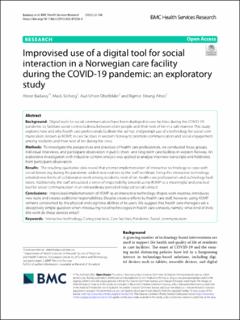| dc.description.abstract | Background
Digital tools for social communication have been deployed in care facilities during the COVID-19 pandemic to facilitate social connectedness between older people and their next of kin in a safe manner. This study explores how and why health care professionals facilitate the ad hoc and prompt use of a technology for social communication, known as KOMP, in care facilities in western Norway to promote communication and social engagement among residents and their next of kin during the crisis.
Methods
To investigate the perspectives and practices of health care professionals, we conducted focus groups, individual interviews, and participant observation in public short- and long-term care facilities in western Norway. An explorative investigation with inductive content analysis was applied to analyse interview transcripts and fieldnotes from participant observation.
Results
The resulting qualitative data reveal that prompt implementation of interactive technology to cope with social distancing during the pandemic added new routines to the staff workload. Using this interactive technology entailed new forms of collaborative work among residents, next of kin, health care professionals and technology facilitators. Additionally, the staff articulated a sense of responsibility towards using KOMP as a meaningful and practical tool for social communication in an extraordinary period of reduced social contact.
Conclusions
Improvised implementation of KOMP as an interactive technology shapes work routines, introduces new tasks and creates additional responsibilities. Despite creative efforts by health care staff, however, using KOMP remains constrained by the physical and cognitive abilities of its users. We suggest that health care managers ask a deceptively simple question when introducing novel technologies in health care contexts, namely: what kind of invisible work do these devices entail? | en_US |

